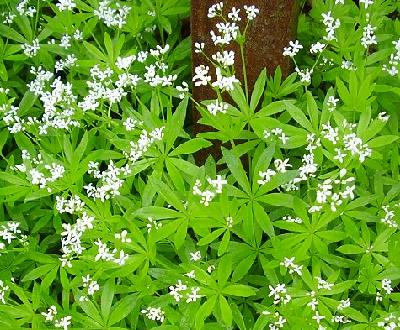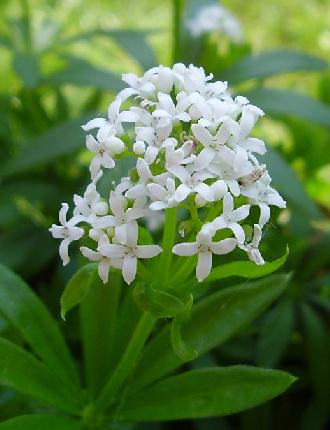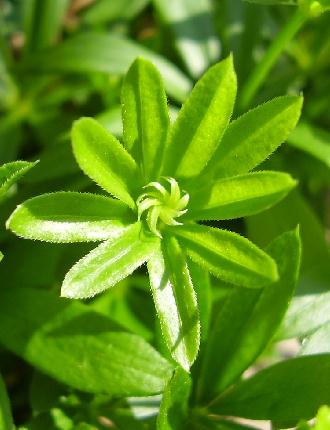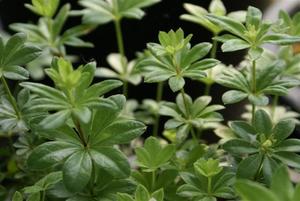Sweet Woodruff
I'm writing this month about a herb that is more often associated with the beginning of May than April, for it is then that fresh sprigs are crushed and added to white wine in countries such as Germany to make wine cups for celebrating May Day or other May festivals such as Beltane. I'm talking of course about sweet woodruff (Galium odoratum formerly Asperula Odorata). This herb is fast growing, quick to establish, and has the most beautiful white spring flowers and attractive leaves that look like tiny windmills un-folding as you await the flowers.
Sweet Woodruff's dried foliage has a sweet scent that has been described by some as freshly mown hay and by others as a soft vanilla fragrance. The fragrance is due to the coumarin present in Sweet Woodruff which increases when the plant wilts and intensifies when it is dried. I get the scent of vanilla hay so I get the best of both worlds.
History & Folklore

Sweet woodruff can be found being used medicinally and as a means of sweetening the air in records dating back as far as the 14th century.
Medieval soldiers believed sweet woodruff promoted success in battle. So they carried it tucked in their helmets. The origin of this belief isn't clear, but it could be born from the fact that woodruff leaves have mildly anaesthetic properties and were thought to lift the spirits, so giving the soldier a sense of invincibility?
In some descriptions of Sweet Woodruff, the writers claim that it went by the names woodrowel and woodrow. In fact those names were the folk names of another of the woodruff family, Squinancy Woodruffe (Asperula cynanchica) which was also known as Quinsywort and Squinancywort. These names indicate that Squinancywort was formerly used for treating quincy, a disease similar to tonsillitis. Squinancywort is no longer used by herbalists because it became harder to source and is now a rare plant most of the British Isles.
Sweet Woodruff was also known as New Mowed Hay, Woodruff, Ladies in the Hay, Waldmeister (German for wood master), Woodward and Kiss Me Quick. In the Middle Ages Sweet Woodruff was woven into wreaths and swags and hung and strewn in churches. It was said to represent humility. Woodruff is carried to attract money and prosperity, to bring victory to athletes and warriors, and, when placed in a sachet of leather, it guards against all harm.
Description
Sweet woodruff is a pretty, herbaceous, moist-and-shade-loving perennial that is a native of Europe, North Africa and Asia. It grows to a height of 30-50 cm. Its leaves are 2-5 cm long, the individual leaflets are lanceolate shaped and occur in whorls of 6 to 9 around the stem. These whorls are repeated all the way up to the flowers as can be seen in the photographs below. The flowers are small with a diameter of 4-7 mm, white in colour and are joined together at the base.

They're more likely to be found featured in garden publications as a flower than a herb these days. As they don't have many herbal uses by the lay person they seem to have fallen off the herb radar and been consigned to the garden plant catalogues.
One place that you can see them growing as a herb is at Hardwick Hall which, not surprisingly, is where the variety 'Hardwick Hall' comes from. I contacted Ian Hunt, the Head Gardener at Hardwick, to enquire about the age of the variety and he sent me the following quote from the first edition of Gardens of the National Trust, by Graham Stuart Thomas, Hardwick's' first Gardens adviser:
'Nobody knows whence came 'Hardwick Hall' Lily of the valley; it is distinguished by it's large bells and broad foliage which has a markedly pale edge'.
So it's a bit of a mystery as nobody knows where it came from, but Ian has promised to dig around and let me know what he finds out. It really is a delightful variety that smells heavenly.
Growing
Sweet woodruff is an ideal plant to use for under planting trees and shrubs. It also makes a pretty foil for growing tulips and late spring/early summer bulbs. It prefers a rich, moist, alkaline soil, but will happily grow in dry shade under trees and shrubs.
Sweet woodruff can spread very quickly using its underground runner style roots, much the same way that mint will spread. So make sure that you thin it out regular to maintain control. The roots are very brittle, so any you leave behind will most likely turn into new plants come the following spring. To prevent this pretty herb taking over the beds and borders, you can also grow it in pots, which is how I grow mine and they thrive, as you can see from the above photographs.
Sweet woodruff can be grown from seed and propagated from root cuttings. If growing from seed, sow in the autumn after you've stratified your seeds (pop in the fridge for about 4 weeks to simulate winter). Root cuttings need to be evenly spaced on the surface of leafy, rich compost and covered with a thin layer of compost on the top. Keep in a warm place until the plants grow, then harden off and plant out about 10cm apart. During long dry summers make sure you keep your keep them well watered.
General Use

Sweet Woodruff can be used as an insect repellent. Place the leaves in sachets and put in drawers, wardrobes and the kitchen.
Another use for sweet woodruff is as a natural plant dye. The leaves produce a light brown dye and the roots a light red when used with alum as a mordant.
To help bring restful sleep, you can make a pillow stuffed with sweet woodruff. It can also be added to pot-pourri. In the Middle Ages sweet woodruff was used as a strewing herb and as a stuffing for mattresses to sweeten the room. It was also popular in Elizabethan England for use in tussie mussies, wreaths, garlands and sachets.
The flowers can be added to salads and summer drinks. You can also make a refreshing summer punch as follows. Put a few flowers and crushed fresh sweet woodruff sprigs into a jug and add a bottle of white wine, a little strawberry liqueur (or sweet sherry if you can’t find strawberry liqueur), and a tablespoon or two of castor sugar, depending how sweet you want the drink to be. Finally add a handful of sliced strawberries and leave to chill in the fridge for a couple of hours.
Medicinal Use
Sweet woodruff contains coumarin glycosides, which ferment slightly as they dry and release coumarin, one of its medicinally active constituents. Others include tannins, anthraquinones and iridoids. These molecules act as anticoagulants, so woodruff can be used to counteract blood clotting. Woodruff has been used internally as a tonic tea. It has diuretic properties and topically it has been used as a compress for varicose veins and phlebitis (an inflammation of the veins, usually in the legs).
It has anti-inflammatory and anti-spasmodic properties, soothes intestinal discomfort, especially abdominal cramps, and can be used to treat headaches and migraine. Sweet woodruff has also been given to children and adults to help with insomnia, and is also a good source of flavonoids, which are useful for their antioxidant properties, and for their ability to help keep small blood vessels toned and healthy. It has also been valued as a treatment for liver disease and kidney stones and as a strengthener for the heart.
Culpeper cited Sweet Woodruff as being a restorative herb, good for people suffering from consumption. He wrote that it was also good for opening obstructions in the liver and spleen and as a provocative to venery, which during Culpeper's time was the way of describing a herbs use as an aphrodisiac!

